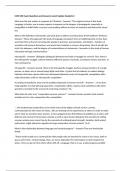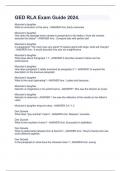CMN 105 Exam Questions and Answers Latest Update Graded A+
What was the text written in response to? (Preface) - Answers "The original version of this book,
Language in Action, was in many respects a response to the dangers of propaganda, especially as
exemplified in Adolf Hitler's success in persuading millions to share his maniacal and destructive views"
(xi).
What is the definition of Semantics and what does it address and what does it NOT address? (Preface) -
Answers "Those who approach the study of language and speech from a traditional point of view have
seen their first as that of correcting the speaker's grammar, pronunciation, and diction...Teachers of
semantics will concern themselves, and teach their students to concern themselves, first of all with the
truth, the adequacy, and the degree of trustworthiness of statements...Semantics is the study of human
interaction through communication."
interspecific - Answers "Biologists distinguish between two kinds of struggle for survival. First, there is
the interspecific struggle, warfare between different species of animals, as between wolves and deer, or
men and bacteria.
intraspecific - Answers Second, there is the intraspecific struggle, warfare among members of a single
species, as when rats or human beings fight each other. A great deal of evidence in modern biology
indicates that those species that have developed elaborate means of intraspecific competition often
make themselves unfit for interspecific competition
According to Hayakawa, what are the qualities important to human survival? - Answers "...If we don't
hang together we shall all hang separately...Cooperation within a species (and sometimes with other
species) is essential to the survival of most living creatures" (5).
What does he refer to as "cooperative nervous systems?" - Answers Human societies (and animal)
societies are for more cooperative then competitive
"...the fundamental cooperative act by which most of the higher animals survive: namely,
communication by the means of noises...We are drawing on the experiences of others in order to make
up for what we ourselves have missed...In fact, gregariousness (friendliness/sociability) as an aid to self-
defense and survival is forced upon animals as well as upon human beings by the necessity of uniting
nervous systems even more than by the necessity of uniting physical strength. Societies, both animal
and human, might almost be regarded as huge cooperative nervous systems" (5-6).
What is the relationship between language and societal progress? - Answers They are inextricably
linked.
"These marks enable us to communicate with people who are beyond the reach of our voices, both in
space and in time...Human beings, then, are never dependent for information on direct experience
alone...They can go on from where others left off...Language, that is to say, makes progress possible"
, What is meant by cultural accomplishments as "free gifts from the dead?" - Answers "Language is the
indispensible mechanism of human life - of life such as ours that is molded, guided, enriched, and made
possible by the accumulation of the past experience of members of our species...The cultural
accomplishments of the ages...come to us as free gifts from the dead. These gifts, which none of us have
done anything to earn, offer us not only the opportunity for a richer life than any of our forebears
enjoyed but also the opportunity to add to the sum total of human achievement by our own
contributions, however small"
What is the definition of "semantic environment?" - Answers "...Mits is affected every hour of his life not
only by the words he hears and uses but also by his unconscious assumptions about language...Words -
the way he uses them and the way he takes them when spoken by others - largely shape his beliefs, his
prejudices, his ideals, his aspirations. They constitute the moral and intellectual atmosphere in which he
lives - in short, his semantic environment"
What are the basic assumptions behind the thesis of this book? - Answers Most societal problems are
rooted in misunderstands and cooperation is essential for survival
"It will be the basic assumption of this book that widespread intraspecific cooperation through the use
of language is the fundamental mechanism of human survival. A parallel assumption will be that when
the use of language results...in the creation or aggravation or disagreements and conflicts, there is
something linguistically wrong with the speaker, the listener, or both. Human fitness to survive requires
the ability to talk, write, listen, and read in ways that increase the chances for you and fellow members
of the species to survive together: (12).
signal reaction - Answers "To the chimpanzee, the red light is, we shall say, a signal, and we shall term its
reaction a signal reaction: that is, a complete and invariable reaction that occurs whether or not the
conditions warrant.
symbol reaction - Answers To the human being, on the other hand, the red light is, in our terminology, a
symbol, and we shall term the human reaction a symbol reaction: that is, a delayed reaction, conditional
upon the circumstances. In other words, the nervous system capable of only signal reactions identifies
the signal with the thing for which the signal stands; the human nervous system, however, working
under normal conditions, understands no necessary connection between the symbol and that for which
the symbol stands" (14).
What is the relationship between symbols and the things symbolized? - Answers "Whenever two or
more human beings can communicate with each other, they can, by agreement, make anything stand
for anything...There is no necessary connection between the symbol and that which is symbolized"
What is Korzybski's "dictum" regarding the relationship between symbols and the things symbolized? -
Answers "...this verbal world ought to stand in relation to the extensional world as a map does to the
territory it is supposed to represent" (20).





